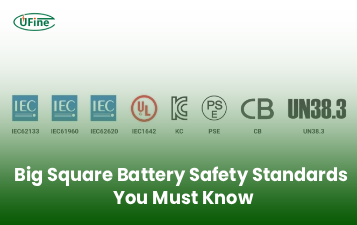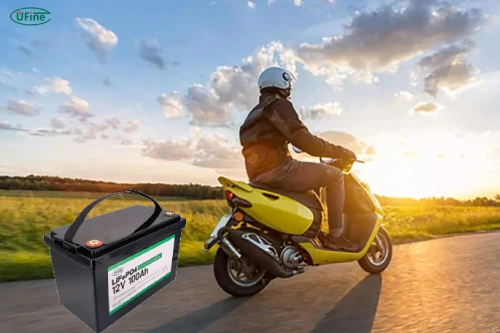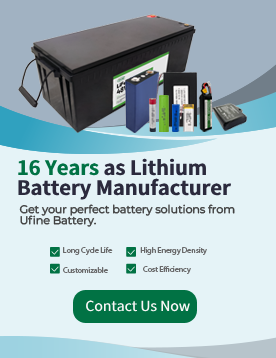
- Part 1. The average lifespan of a motorcycle scooter battery
- Part 2. Factors that influence battery longevity
- Part 3. Comparing common scooter battery types
- Part 4. Symptoms of a weak or failing scooter battery
- Part 5. How to test a motorcycle scooter battery
- Part 6. Maintenance tips to extend battery lifespan
- Part 7. Advantages of switching to lithium or LiFePO4 batteries
- Part 8. How to store and care for your battery during off-season
- Part 9. When to replace a scooter battery
- Part 10. FAQs
How long does a motorcycle scooter battery last? The answer depends on several factors: the battery type, your riding habits, maintenance routine, and even the weather. In this comprehensive guide, we’ll explore all the details—from typical lifespan and influencing factors to testing, maintenance, and replacement tips.
Part 1. The average lifespan of a motorcycle scooter battery
A standard motorcycle scooter battery typically lasts between 2 and 5 years. However, the actual lifespan can vary dramatically based on the battery type and how it’s maintained.
- Conventional lead-acid batteries: 2–3 years on average
- Absorbed Glass Mat (AGM) batteries: 3–4 years
- Gel batteries: 3–5 years
- Lithium-ion or LiFePO4 batteries: 4–8 years
Lithium batteries are becoming increasingly popular due to their lightweight design, long cycle life, and low maintenance requirements. For riders who value reliability and performance—especially those using electric scooters—lithium batteries are a smart investment.
🔋 Expert Insight: Ufine Battery manufactures high-quality lithium polymer, LiFePO4, and 18650 batteries for scooters, motorcycles, and e-bikes. Each battery is customized in voltage, capacity, and size to ensure a perfect fit and superior endurance.
Part 2. Factors that influence battery longevity
Battery life isn’t determined by age alone—it’s shaped by a combination of environmental and mechanical factors. Here’s a breakdown:
(1) Battery Chemistry and Quality
Battery chemistry plays the largest role in lifespan.
- Lead-acid batteries rely on chemical reactions between lead plates and electrolyte; over time, these plates corrode.
- Lithium-ion batteries use advanced materials that resist degradation, offering up to 2–3 times longer life.
The build quality and cell balancing also matter. Cheap batteries often fail early due to inconsistent internal resistance or weak sealing.
(2) Riding Frequency and Duration
Frequent short trips under 10 minutes don’t allow the alternator to recharge the battery fully, leading to chronic undercharging.
Longer, consistent rides keep the battery topped up and healthy.
(3) Climate and Temperature
Extreme heat accelerates electrolyte evaporation and internal corrosion, while freezing cold slows chemical activity, making it harder to start your engine.
If you live in areas with harsh seasons, LiFePO4 batteries (like those produced by Ufine) are ideal because they offer superior temperature tolerance from -20°C to 60°C.
(4) Electrical Accessories
Adding heated grips, GPS devices, or custom lighting increases the load on your electrical system. This can drain your battery faster—especially if the alternator can’t keep up.
(5) Maintenance Habits
Failing to clean terminals, ignoring corrosion, or using an incompatible charger shortens battery life dramatically. Using a smart charger ensures optimal voltage without overcharging.
Part 3. Comparing common scooter battery types
| Battery Type | Cycle Life | Maintenance | Weight | Typical Lifespan | Key Features |
|---|---|---|---|---|---|
| Flooded Lead-Acid | 300–400 | Regular | Heavy | 2–3 years | Low cost, requires topping up electrolyte |
| AGM | 400–600 | Low | Medium | 3–4 years | Spill-proof, vibration-resistant |
| Gel | 500–700 | Low | Medium | 3–5 years | Stable performance, deep cycle capable |
| Lithium-Ion | 1,000–2,000 | Minimal | Very Light | 4–6 years | Fast charging, stable voltage |
| LiFePO4 | 2,000–3,000 | Minimal | Very Light | 5–8 years | Longest life, wide temperature range |
⚙️ Ufine Battery provides custom lithium and LiFePO4 battery packs designed specifically for scooters and motorcycles. Whether you need compact 12V modules or high-discharge packs, Ufine delivers optimized performance and long cycle life.
Part 4. Symptoms of a weak or failing scooter battery
Recognizing early warning signs can save you from being stranded. Watch for:
- Slow engine crank: The starter motor turns sluggishly before ignition.
- Dimming lights or weak horn: Voltage drop under load.
- Dashboard flickering: Unstable voltage regulation.
- Battery swelling or leakage: Internal pressure buildup or cell failure.
- Frequent charging required: Battery losing capacity.
If your battery exhibits two or more of these symptoms, it’s time for testing or replacement.
Part 5. How to test a motorcycle scooter battery
Testing helps determine whether the issue lies with the battery or the charging system.
Visual Inspection
Look for cracks, corrosion, or bulging. Damaged cases or leaking electrolyte indicate the battery is unsafe to use.
Measure Voltage
Using a multimeter:
– Fully charged 12V lead-acid battery: 12.6–12.8V
– Fully charged lithium battery: 13.2–13.4V
If the reading is below 12V, charge the battery and retest. If it drops again within 24 hours, internal degradation is likely.
Load Test
Use a load tester or visit a workshop. A healthy battery should maintain voltage above 9.6V during a 10-second cranking test.
Part 6. Maintenance tips to extend battery lifespan
A little care goes a long way. Follow these professional tips:
1. Keep the Battery Charged
If your scooter sits idle for long periods, use a trickle charger or battery maintainer.
Lithium batteries from Ufine Battery retain charge exceptionally well—often holding 80% capacity even after six months of storage.
2. Avoid Deep Discharge
Consistent deep discharges below 10V reduce cycle life. Recharge promptly after each use.
3. Maintain Clean Terminals
Corrosion increases resistance and reduces charging efficiency. Clean with baking soda and a wire brush, then apply dielectric grease.
4. Check Voltage Regularly
A quick voltage check every few weeks helps spot problems early.
5. Store Properly
During off-season storage:
- Disconnect the negative terminal
- Store in a cool, dry environment (15–25°C)
- Recharge every 2–3 months (lead-acid) or 4–6 months (lithium)
Part 7. Advantages of switching to lithium or LiFePO4 batteries
Modern riders are rapidly upgrading to lithium and LiFePO4 scooter batteries for their superior performance. Here’s why:
- Longer Cycle Life: Up to 3–5 times that of lead-acid batteries.
- Lighter Weight: Up to 70% lighter, improving acceleration and handling.
- Faster Charging: Fully charges within 1–2 hours.
- Stable Output: Maintains high voltage even under heavy loads.
- Safe and Environmentally Friendly: LiFePO4 chemistry is stable, non-toxic, and thermally safe.
⚡ Ufine Battery is a professional custom lithium battery supplier with over 17 years of manufacturing experience.
We produce lithium polymer, LiFePO4, 18650, cylindrical, and ultra-thin batteries, each designed for demanding applications like scooters, motorcycles, and EVs.
Part 8. How to store and care for your battery during off-season
Scooter owners who park for winter often face dead batteries in spring. Here’s how to prevent that:
- Fully charge the battery before storage.
- Disconnect it from the scooter to prevent parasitic drain.
- Store at 50–70% charge for lithium batteries; fully charged for lead-acid.
- Avoid direct sunlight or damp areas.
- Periodically check voltage and top-up charge if necessary.
Ufine’s lithium batteries feature low self-discharge rates (<3% per month), making them ideal for long-term storage.
Part 9. When to replace a scooter battery
You should replace your motorcycle scooter battery if:
- It’s older than 3–5 years
- It frequently fails to start even when charged
- Voltage drops quickly under load
- It shows physical damage, swelling, or leakage
When upgrading, consider moving to a LiFePO4 battery. Although slightly more expensive upfront, it offers exceptional cycle life and consistent performance—making it cost-effective in the long run.
🔋 Ufine Battery provides custom-made lithium and LiFePO4 replacement packs for motorcycles and scooters.
Contact our team to get a tailored lithium solution with the exact voltage, capacity, and dimensions for your model.
Part 10. FAQs
What’s the difference between lead-acid and lithium scooter batteries?
Lithium batteries are lighter, charge faster, and have a longer cycle life. They also maintain voltage better under load.
How do I know if my scooter battery is bad or just discharged?
Test with a multimeter. If the voltage rebounds after charging but drops quickly again, it’s likely failing.
Can I replace a lead-acid battery with a lithium battery?
Yes, in most cases—just ensure voltage compatibility. Ufine Battery can customize lithium packs specifically designed to replace lead-acid types.
How should I maintain my scooter battery during winter?
Keep it charged with a maintainer or remove and store it indoors at moderate temperatures.
Related Tags:
More Articles

Big Square Battery Safety Standards You Must Know
Learn key safety standards for big square batteries to avoid fire risks, shipping delays, and compliance issues in EV, industrial, and energy storage projects.
Big Square Battery Applications in Solar & Industrial Equipment
Big square batteries deliver high capacity, stable output, and long life for solar, industrial, and backup power. Explore key uses and advantages.
Big Square Battery vs Cylindrical Battery: Complete 2025 Guide for EVs, ESS & Industrial Devices
Choosing the right battery is key for designers and engineers. Compare big square vs cylindrical batteries to find the best fit for your application.
How to Choose the Right Big Square Battery for Your Device?
If you’re choosing a big square battery for EVs, solar, or mobility devices, this guide helps you pick the right solution for real-world needs.
Big Square Battery Complete Guide: Types, Uses & Buying Tips
If you are choosing a big square lithium battery for EVs, solar, RVs, or AGVs, this guide helps you select the right NMC, LFP, or LTO solution with examples.



